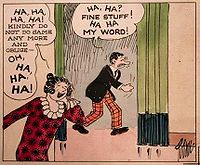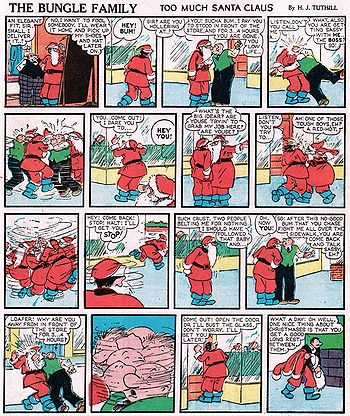
Bungle Family
Encyclopedia

United States
The United States of America is a federal constitutional republic comprising fifty states and a federal district...
comic strip
Comic strip
A comic strip is a sequence of drawings arranged in interrelated panels to display brief humor or form a narrative, often serialized, with text in balloons and captions....
, created by Harry J. Tuthill
Harry J. Tuthill
Harry J. Tuthill was an American cartoonist best known for his comic strip The Bungle Family.Born in Chicago, Illinois, he grew up in the tenements and worked as a newsboy, quitting when a tough guy muscled in on his corner...
, that first appeared in 1918. Originally titled Home, Sweet Home, it first appeared as part of a series of rotating strips in the New York Evening Mail
New York Evening Mail
The New York Evening Mail was an American daily newspaper published in New York City.The paper was made up of the New York Evening Express, which dated from 1836, and the Daily Advertiser. It was eventually merged with the Evening Telegram, which became the New York World-Telegram in 1927.From New...
.
Characters and story
Known as "the finest, most inventive and socially critical of the family strips," The Bungle Family was a popular domestic comedy that emphasized dialogue and realistic situations. The titular patriarch of the strip, long-suffering, cantankerous George Bungle, voiced the petty frustrations and joys of the common man during the Jazz AgeJazz Age
The Jazz Age was a movement that took place during the 1920s or the Roaring Twenties from which jazz music and dance emerged. The movement came about with the introduction of mainstream radio and the end of the war. This era ended in the 1930s with the beginning of The Great Depression but has...
and through the Depression.

Daily strip
A daily strip is a newspaper comic strip format, appearing on weekdays, Monday through Saturday, as contrasted with a Sunday strip, which typically only appears on Sundays....
and was nationally syndicated by the end of 1919. Home, Sweet Home followed the adventures of Mabel (later Josephine) and George, a young couple beset on all sides by in-laws, neighbors and businessmen.
Tuthill took the strip to the McNaught Syndicate
McNaught Syndicate
The McNaught Syndicate was an American newspaper syndicate founded in 1922. It was established by Virgil Venice McNitt and Charles V. McAdam. Its best known contents were the columns by Will Rogers and O. O. McIntyre, the Dear Abby letters section and comic strips, including Joe Palooka and...
when the Evening Mail was sold in 1924, changing the name to The Bungle Family and adding daughter Peggy Bungle to the cast. A Sunday page
Sunday strip
A Sunday strip is a newspaper comic strip format, where comic strips are printed in the Sunday newspaper, usually in a special section called the Sunday comics, and virtually always in color. Some readers called these sections the Sunday funnies...
was in existence by September 9, 1923. Comics historian Don Markstein
Don Markstein's Toonopedia
Don Markstein's Toonopedia was a web encyclopedia of print cartoons, comic strips and animation. Don D...
described life among the Bungles:
- George was skinny, middle-aged, cucumber-nosed and mustachioed, sort of like A. MuttMutt and JeffMutt and Jeff was a long-popular American newspaper comic strip created by cartoonist Bud Fisher in 1907 about "two mismatched tinhorns." It is commonly regarded as the first daily comic strip. The concept of a newspaper strip featuring recurring characters in multiple panels on a six-day-a-week...
, Andy GumpThe GumpsThe Gumps, a popular comic strip about a middle-class family, was created by Sidney Smith in 1917, launching a 42-year run in newspapers from February 12, 1917 until October 17, 1959....
or the self-caricatures of R. CrumbRobert CrumbRobert Dennis Crumb —known as Robert Crumb and R. Crumb—is an American artist, illustrator, and musician recognized for the distinctive style of his drawings and his critical, satirical, subversive view of the American mainstream.Crumb was a founder of the underground comix movement and is regarded...
. Josie was his equivalent, not a dowdy old frump, but about as comfortably domestic looking as Mutt's or Andy's wife, or to cite a more recent example, Mrs. Ferd'nandFerd'nandFerd'nand is a pantomime comic strip notable for its lack of word balloons and captions, lack of continuity and its longevity .-Background:Ferd'nand was first published in 1937 by the Presse-Illustrations-Bureau of Copenhagen...
. They were typical lower middle class city people of the time, living in a walk-up apartment and having frequent run-ins with the landlord, bill collectors, neighbors and most of all, each other. George and Jo would fight over practically anything. Their disputes frequently went on for hours, provoked noise complaints to the police, dragged the neighbors in, or all three. They were not very likable, and certainly not high-minded. But they were funny. Through them, Tuthill displayed a sort of amused contempt for the more petty concerns of ordinary urban life. The Bungles weren't the sort of folks most people would want to live downstairs from, but they were very much capable of providing entertainment for those who didn't have to put up with them in person.
In the mid-1930s, Tuthill serialized exotic adventures and introduced a large supporting cast over the next several years—moves that were accompanied by a huge surge of public interest in the strip.

Reprints
Reprints of the strip were featured in the comic book Feature FunniesFeature Funnies
Feature Funnies was a comic book anthology title published by Comic Favorites, Inc. in the United States for 20 issues from 1937 until 1939. Feature Funnies cannily mixed color reprints of popular newspaper comic strips like Joe Palooka, Mickey Finn and Dixie Dugan with a smattering of new...
beginning in 1937. Despite its fame, the strip was brought to a conclusion by its creator on August 1, 1942. Revived on May 17, 1943, it ended permanently June 2, 1945.

The Comics Journal
The Comics Journal, often abbreviated TCJ, is an American magazine of news and criticism pertaining to comic books, comic strips and graphic novels...
. In 2006, it was announced that Spec Publications, a Colorado-based publisher of classic comics, planned to reprint The Bungle Family in collected editions.
Today, The Bungle Family can be read online at Steve Cottle
Steve Cottle
Steve Cottle, Jr. , dedicated to the preservation of vintage comic strips, is also known as Mr. ilovecomix. In 2008, he founded the I Love Comix Archive and began to recruit vintage comic strip collectors as contributors, noting, "This is a collaborative effort to save and digitize old newspaper...
's I Love Comix Archive.
- Famous Funnies #13, Aug. 1935, Eastern Color (Bungle Family, "Another Red Letter Day" and Little Brother, untitled)
- Famous Funnies #17, Dec. 1935, Eastern Color (Bungle Family and Little Brother, untitled)
Books
- Home, Sweet Home. New York: M.S. Company, 1925.
- Waugh, Coulton, The Comics, MacMillan, 1947, 1991, p.110-111.
- The Bungle Family: A Complete Compilation, 1928 / Harry J. Tuthill; introduction by Bill Blackbeard, The Hyperion library of classic American comic strips, Westport, Connecticut: Hyperion Press, 1977. LCCN 76053057 ISBN 0883556693
- Hunter, Julius K., Westmoreland and Portland places: the history and architecture of America's Premier Private Streets, 1888-1988 (St. Louis, Missouri), University of Missouri Press, Columbia, Missouri, 1988, p.84.
External links
- Flickr
- Lambiek: The Bungle Family
- "The Press: Bungle". Time, August 18, 1930)
- Modern Mechanix, October 1936

